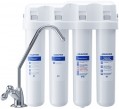Stages of purification
The number of purification stages provided for in the filter design. At each stage, water passes through its own filter element, clearing itself of certain contaminants; in this case, the steps are arranged in order from coarser cleaning to finer. For example,
a three-stage system may look like this: the first stage is mechanical removal of impurities, the second stage is the removal of ferrous, and the third is filtration through a carbon cartridge.
The more stages of purification — the more advanced the filter is considered, the cleaner water it usually provides at the outlet. Accordingly, this moment largely depends on the purpose (see “Type”): for example, multi-stage filtration is quite rare in main models, it is practically not used at all in pre-filters, but the number of stages can reach 9 in models for sink.
Pollution clipping
The smallest size of foreign particles (in microns) that the filter can hold in total. Accordingly, the smaller this size, the higher the filtration efficiency, the less undissolved impurities remain in the filtered water. On the other hand, finer cleaning usually takes more time, which affects the speed (throughput) of the filter. It should be noted that in the case of using reverse osmosis filters, the filtration is very fine, up to 0.01 microns.
Filtration speed
The amount of water that the filter is able to pass through itself per unit of time (of course, effectively purified in the process); usually stated in liters per minute. This parameter is largely related to the type (see above): for example, in jugs, the filtration rate usually does not exceed 0.5 L per minute, while for main devices that supply entire apartments, a throughput of tens or even hundreds of liters is required.
Note that it does not always make sense to pursue a high filtration rate. After all, other things being equal, finer cleaning takes more time; accordingly, the faster the filter works, the higher the chance that the quality of such cleaning will be relatively low. And devices that purify water efficiently and quickly usually have an appropriate price. Therefore, it is worth considering the purpose of the filter and, on the basis of this, determine the balance between the filtration speed and its quality when choosing. It is also worth keeping in mind the conditions of use: for example, if you need to filter low-quality tap water for drinking, it is better to sacrifice speed in favor of efficiency.
Resource
The resource can be described as the total amount of water (in thousands of liters) that the filter is able to clean before the cartridge needs to be changed. Usually, it is indicated for a standard filter element (see "Removable cartridges").
Different types of filters (see above) can significantly differ in resource, depending on the features of their application. However, for all models, the rule applies: do not use a cartridge that has exhausted its resource. This is due not only to a drop in filtration efficiency — an “overfilled” filter can begin to release the accumulated contents into the water, further degrading its quality. Since it can be quite difficult to monitor of a specific amount of treated water, many manufacturers indicate the approximate time in which it will be exhausted with an average intensity of use in addition to the resource. Usually it is a few months, but there are exceptions. In addition, for the convenience of the user, various indicators can be provided in the filter design (see "Cartridge replacement indicator").
In models with a multi-stage design (see "Stages of purification"), where there are several cartridges, their resource usually differs, and the total filter resource is usually indicated by the least durable cartridge, that is, until the first replacement of any of the filter elements.
Capillary membrane
The presence of a
capillary membrane in the filter design.
The capillary membrane is a filter element consisting of numerous thin (up to a millimetre in diameter) synthetic tubes — capillaries — with villi on the inner surface. Water passes through such tubes freely, and foreign contaminants are retained. According to the principle of operation, the capillary membrane is a mechanical filter, but unlike conventional elements of this type (see "Pollutants clipping"), it is capable of retaining much smaller particles — up to hundredths of a micron inclusive. This is enough to remove from the water not only insoluble impurities that were missed in the previous stages, but also most bacteria. Therefore, capillary membranes are classified as fine filters and are often used at the last stage of the process.
Replacement cartridges
Models of replaceable cartridges for which the filter is designed. Knowing the names of models, it will be much easier for you to find a replacement for an exhausted cartridge. In addition, the options directly named by the manufacturer are fully compatible with the filter and correspond to official specifications, while there is no such guarantee for "non-native" cartridges.
Several names in this paragraph are usually indicated for filters with multi-stage filtration (see "Stages of purification") — a cartridge for each stage.

